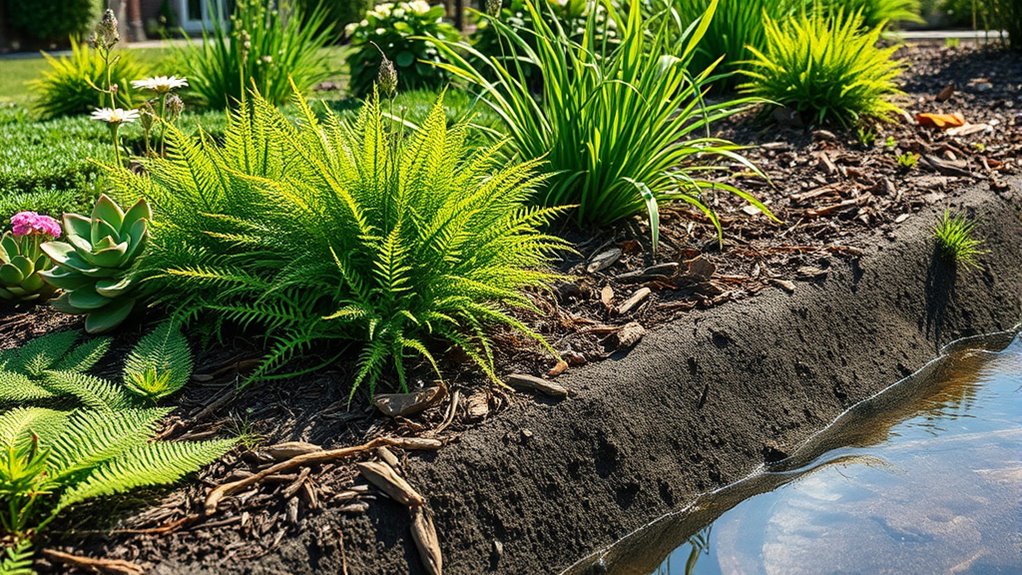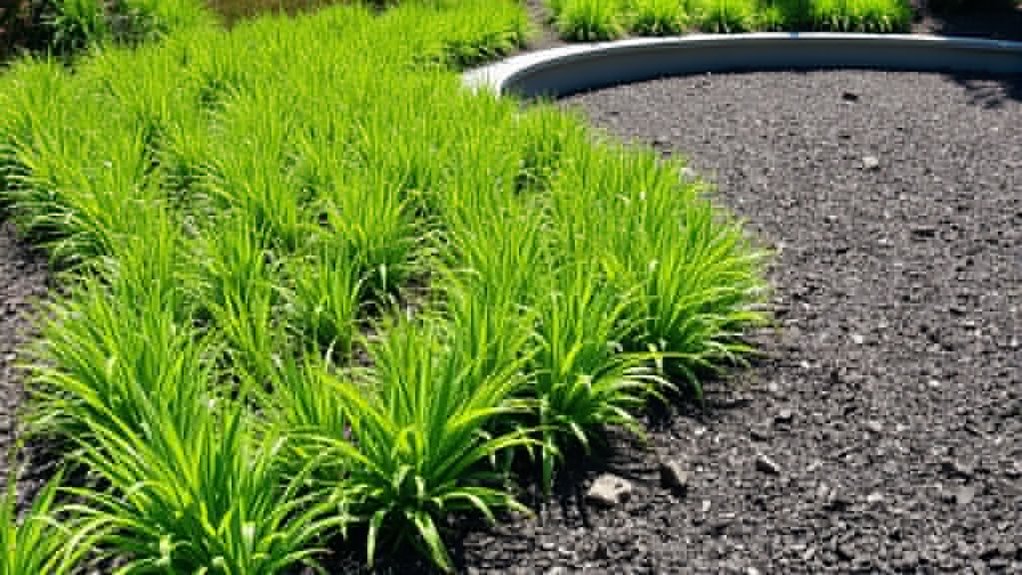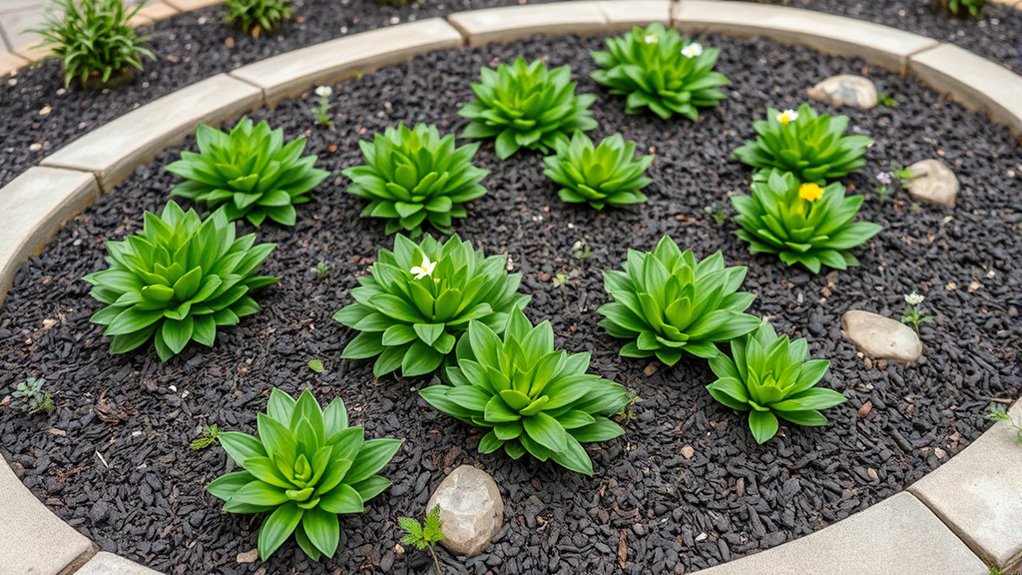To create low-litter landscaping that won’t clog the basin, choose native plants like grasses, succulents, and evergreen shrubs that shed little debris. Design your landscape with drainage in mind by grouping plants with similar water needs and incorporating permeable surfaces, swales, and depressions. Use ground covers, mulch, and windbreaks to reduce wind-blown debris. Regular maintenance and monitoring help keep your basin clean and functioning. Keep exploring for more tips on sustainable landscape design.
Key Takeaways
- Select native, low-shedding plants like groundcovers, succulents, and evergreen shrubs for minimal debris.
- Design landscapes with proper grading, swales, and permeable surfaces to enhance drainage and prevent basin clogging.
- Use wind-resistant plants and windbreaks to reduce wind-blown debris dispersal and maintain cleanliness.
- Incorporate organic mulch and ground covers to suppress debris, improve soil, and promote tidy, low-maintenance areas.
- Regularly inspect and maintain plant health, remove debris, and clear inlets to ensure ongoing basin functionality.
Choosing the Right Low-Litter Plant Species

When selecting low-litter plant species, it’s important to take into account how much debris they naturally shed and how well they fit into your landscape. Some plants drop fewer leaves or flowers, making cleanup easier and reducing clogging risks. Look for species like certain grasses, succulents, or evergreen shrubs known for minimal shedding. Also, think about their growth habits and size to ensure they complement your space without overcrowding. Avoid plants that drop large amounts of leaves or flowers frequently, which can quickly accumulate and cause drainage issues. Native plants are often better choices because they’re adapted to your environment and tend to be less messy. Additionally, choosing plants with minimal maintenance needs can help keep your landscape tidy over time. By choosing the right species, you’ll create a low-maintenance landscape that stays tidy and functional.
Designing Your Landscape for Drainage Efficiency

To guarantee your landscape effectively manages water runoff, it’s vital to design with drainage efficiency in mind. Begin by evaluating your property’s natural slope and flow patterns. Position low-lying areas where water naturally collects, and avoid placing plants or structures that could obstruct water movement. Incorporate swales or shallow depressions to direct runoff safely away from foundations and paved surfaces. Use permeable materials for pathways and patios to allow water to seep into the ground instead of pooling. Group plants with similar water needs to prevent overwatering and runoff. Consider installing drainage solutions like French drains if necessary. Additionally, implementing necessary cookies during planning can help monitor and optimize water flow in your landscape. By planning thoughtfully, you ensure water flows smoothly through your landscape, reducing erosion, preventing basin clogging, and creating a healthier, more functional outdoor space.
Incorporating Native Plants for Sustainability

Incorporating native plants into your landscape not only enhances its beauty but also promotes long-term sustainability. Native plants are adapted to your region’s soil, climate, and rainfall, reducing the need for extra watering, fertilizers, or pesticides. They support local wildlife, providing essential food and shelter for pollinators, birds, and insects. Additionally, native plants typically require less maintenance, saving you time and effort. To help you choose the right plants, here’s a quick guide: native plant benefits include their ability to thrive with minimal intervention and their role in fostering ecosystem health.
| Plant Type | Benefits | Suitable Examples |
|---|---|---|
| Groundcovers | Prevent erosion, reduce litter | wild strawberry, creeping thyme |
| Shrubs | Provide habitat, filter runoff | dogwood, serviceberry |
| Perennials | Bloom annually, attract pollinators | purple coneflower, black-eyed Susan |
Strategies for Reducing Wind-Dispersed Debris

To reduce wind-dispersed debris, you should focus on selecting plants that resist wind damage, such as native or sturdy species. Implementing ground covers can help stabilize soil and minimize debris blowing away, while installing effective windbreaks can slow wind speeds and protect your landscape. These strategies work together to keep your yard cleaner and more resilient against strong gusts. Additionally, choosing plants with high structural integrity can further enhance your landscape’s resistance to wind damage.
Selecting Wind-Resistant Plants
Choosing wind-resistant plants is essential for minimizing debris during storms and strong gusts. When selecting these plants, focus on species with sturdy stems, dense foliage, and deep roots that anchor them securely. Native plants often perform better in local wind conditions and require less maintenance. Avoid plants with weak branches or tall, spindly growth that easily break off. Incorporate plants that:
- Have flexible stems to bend without snapping
- Grow close to the ground to reduce wind exposure
- Feature dense foliage to catch and hold debris
- Possess deep root systems for stability
- Are suited to your local climate and wind patterns
- Utilize advanced sensors to better understand and adapt to environmental conditions, improving their resilience against wind damage.
Implementing Ground Covers
Have you considered how ground covers can substantially reduce wind-dispersed debris in your landscape? Planting dense, low-growing ground covers creates a natural barrier that minimizes the amount of loose leaves, grasses, and small debris available to be blown away. These plants fill gaps between larger vegetation, stabilizing soil and preventing erosion, which also decreases debris dispersal. When choosing ground covers, opt for sturdy, fast-spreading species like creeping juniper, vinca, or sedum, which establish quickly and form a thick mat. Regular maintenance, such as trimming and removing dead material, enhances their effectiveness. Incorporating top-performing ground covers can further optimize debris reduction and promote a lush, resilient landscape. By implementing ground covers thoughtfully, you create a more stable, low-litter environment that reduces wind-driven debris, keeping your landscape cleaner and healthier over time.
Installing Windbreaks Effectively
Installing windbreaks effectively is essential for reducing wind-dispersed debris in your landscape. Properly placed barriers slow wind flow, minimizing the disturbance of loose leaves, twigs, and small debris. To maximize their effectiveness, consider these strategies:
- Position windbreaks perpendicular to prevailing winds for ideal protection
- Use dense, evergreen plants for year-round wind reduction
- Vary heights and plant layers to create a more effective barrier
- Ensure gaps are minimal to prevent wind channels
- Incorporate natural materials like shrubs and trees to blend with the landscape
Maintenance Tips for a Clean and Healthy Basin

To keep your basin clean and healthy, regular maintenance is essential. Start by inspecting the basin after storms or heavy rain, removing any debris like leaves or branches that could clog the system. Keep an eye on sediment buildup and gently remove excess sediment when necessary. Maintain healthy plant growth by trimming overgrown or dead vegetation to prevent blockages and promote airflow. Check inlets and outlets regularly, ensuring they’re free of obstructions. Avoid using chemical fertilizers or pesticides that can harm water quality. Instead, opt for organic compost and natural pest control methods. Keep the basin’s surrounding area tidy, minimizing litter and non-biodegradable materials. Consistent upkeep guarantees your basin functions properly, supports healthy plant life, and reduces the risk of clogging or pollution. Additionally, understanding the drainage system can help you identify potential issues before they become major problems.
Using Mulch and Ground Cover to Minimize Litter

Using mulch and ground cover helps keep your garden tidy by catching debris before it hits the ground. Organic layers break down naturally, reducing waste and the need for cleanup. By choosing the right ground cover, you can effectively suppress litter and maintain a cleaner, healthier space. Additionally, selecting appropriate ground cover can contribute to soil filtration and improve overall water quality in your landscape.
Mulch Reduces Debris
Mulch and ground covers are effective tools for minimizing litter in your garden. They act as a barrier, preventing leaves, twigs, and other debris from scattering across your landscape. By keeping debris contained, you reduce the need for frequent cleanup and help maintain a tidy appearance. Plus, mulch discourages weeds, which often shed unwanted material, further reducing litter. When choosing mulch, consider organic options like wood chips or bark, which decompose naturally and enrich the soil. Proper mulching also helps retain moisture, decreasing erosion and runoff that can carry debris into storm drains.
- Prevents loose debris from spreading
- Reduces weed growth and shedding
- Keeps soil in place during storms
- Decreases maintenance time
- Enhances overall landscape health
Ground Cover Suppresses Litter
Have you noticed how ground covers and mulch can keep your garden cleaner? When you install low-growing plants or spread mulch, they act as a barrier that prevents leaves, twigs, and other debris from settling on bare soil. This reduces the amount of litter that needs to be cleaned up regularly. Ground covers also discourage weeds, which can trap and hold litter, making your garden neater. By covering the soil, these plants and mulches create a tidy, uniform appearance and keep debris from washing into your basin during storms. You’ll spend less time raking and sweeping, and your landscape will look well-maintained. Using ground cover is an effective, natural way to minimize litter while enhancing your garden’s aesthetic. Additionally, selecting artistic planter designs with integrated ground cover elements can further improve outdoor cleanliness and visual appeal.
Organic Layers Minimize Waste
When you add organic layers like mulch and ground cover to your garden, they act as natural barriers that reduce waste and litter. These layers trap debris, prevent soil erosion, and discourage weeds from spreading, helping your landscape stay clean. By covering bare soil, you minimize the chances of leaves, twigs, and other organic debris from becoming litter. Additionally, organic layers break down over time, enriching the soil and reducing the need for wasteful replacements.
- Suppress weed growth naturally
- Trap fallen leaves and debris
- Protect soil from erosion
- Promote healthy soil biology
- Reduce the need for frequent cleanup
Using mulch and ground cover creates a tidy, eco-friendly garden that minimizes waste and keeps your landscape sustainable.
Monitoring and Adjusting Your Landscape Over Time

Monitoring your landscape regularly is essential to guarantee your planting plans succeed over time. Walk through your yard frequently to check plant health, soil moisture, and drainage. Look for signs of stress, pests, or disease, and address issues promptly. Observe how plants grow and whether they’re filling in as expected; this helps you identify areas needing thinning or additional planting. Adjust watering schedules based on seasonal changes and rainfall patterns. If you notice mulch settling or weeds emerging, replenish or weed as needed to maintain low litter. Prune overgrown plants to keep airflow and prevent clogging. By staying attentive and making small adjustments, you ensure your landscape remains healthy, functional, and aligned with your eco-friendly goals. Regular monitoring keeps your low-litter design thriving long-term. Incorporating soil health practices enhances plant resilience and overall landscape sustainability.
Frequently Asked Questions
How Do Seasonal Changes Affect Low-Litter Landscaping Effectiveness?
Seasonal changes can impact your low-litter landscaping by influencing plant growth and debris levels. During fall, leaves may increase litter, so you’ll need to clear them more often to prevent clogging. In winter, some plants become dormant, reducing litter but requiring protection from cold. Spring and summer boost growth, but regular maintenance ensures debris doesn’t accumulate and clog the basin. Staying proactive keeps your landscape effective year-round.
What Are the Best Irrigation Methods to Prevent Litter Buildup?
You should use drip irrigation or soaker hoses to prevent litter buildup. These methods deliver water directly to the plant roots, reducing overspray and runoff that can carry debris into basins. Automated systems with timers help maintain consistent watering schedules, minimizing manual errors. Regular inspections ensure no debris blocks emitters. By choosing precise, efficient irrigation, you keep your landscape healthy while preventing litter from clogging the basin.
Can Urban Pollution Impact the Plant Choices for Low-Litter Landscapes?
Urban pollution can totally mess with your plant choices, making it seem like a battlefield out there. You’ll need to pick tough, pollution-resistant plants that can handle dirty air and contaminated soil. Think hardy ground covers, native plants, or species known for their resilience. These choices prevent litter buildup and keep your landscape low-maintenance. So, yes, pollution impacts your plant options—choose wisely to guarantee your landscape stays clean and vibrant.
How Does Soil Type Influence Plant Selection for Drainage-Friendly Landscapes?
Soil type directly affects your plant choices for drainage-friendly landscapes. You should select plants suited to sandy or well-draining soils if your soil drains quickly, as they thrive without becoming waterlogged. Conversely, if you have clay soil that retains moisture, choose plants tolerant of wetter conditions to prevent root rot. Understanding your soil helps you pick the right species, ensuring healthy growth and effective drainage.
Are There Specific Pests That Threaten Low-Litter, Basin-Friendly Plants?
You should watch out for pests like aphids, scale insects, and spider mites, which can threaten low-litter, basin-friendly plants. These pests often target tender new growth or stressed plants, so regular inspections are key. Keep your plants healthy with proper watering, avoid over-fertilizing, and consider using natural predators or insecticidal soaps. Staying vigilant helps prevent infestations from spreading and keeps your landscape thriving without clogging the basin.
Conclusion
With thoughtful planting and consistent care, you can create a basin that’s both beautiful and basura-free. By balancing bold native plants, strategic mulch, and diligent maintenance, you’ll reduce debris and drain disruptions. Keep monitoring, modifying, and maintaining your landscape, making it a marvelous, manageable haven. Remember, wise watering, vigilant vigilance, and vibrant vegetation will keep your basin pristine and picturesque, proving that sustainable, low-litter landscaping is both simple and satisfying.










